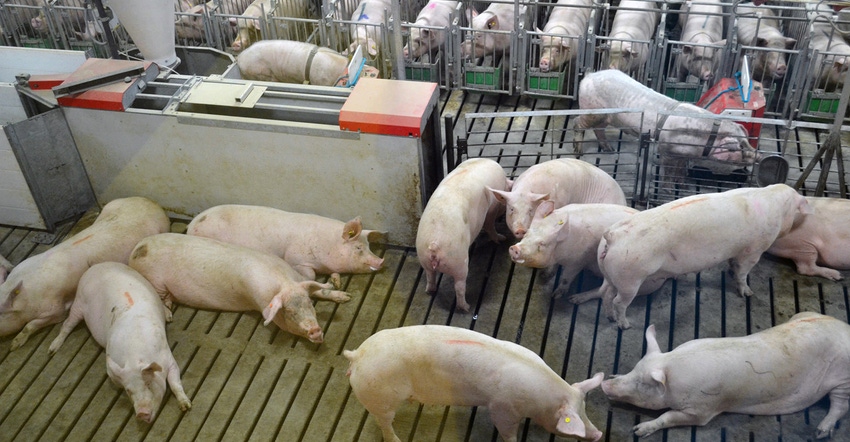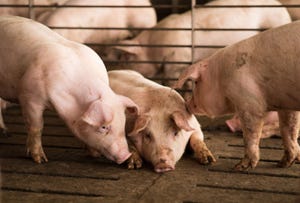Prop 12 farm design needs to match your people, goals
Swine veterinarian says preventing aggression, fighting key to reducing lameness, sow death loss.

For pork producers considering a Proposition 12 site conversion, Chris Sievers first suggests making sure the farm design fits the production system and staff.
“I don't think there's a perfect one out there today to be honest, and it's really what fits your people and your goals the best,” Sievers says.
A veterinarian with Swine Vet Center, Sievers has consulted on several Prop 12 sites with various layouts, such as 60-head electronic sow feeder pens, 15-to-20-head station pens and 280-head ESF pens. He has worked closely with their production staff to evaluate and improve production, especially with breeding procedures to reduce sow fighting and keep staff safe.
“Free stalls are an excellent tool, being able to have that for that six-hour period of lock down and release during that breeding time, and honestly it gives the sow an area to go lay down during a period of aggression she wouldn't have otherwise if you're just in an open pen setting,” Sievers says.
“After we get through that initial gilt stocking, you'll have 80 to 90% of those sows choose to lay in these even when they're unlocked. They have food, water and shelter … they got life made. They're not going to get beat up by the dominant five or six sows out in the back of those and certainly one of the best tools we have today to help us with Prop 12, no matter the style or design of the free stall.”
Small pen breeding is also possible for a Prop 12 system, especially with gilts, however Sievers says it takes the right people and system.
Controlling the fighting and pecking order comes down to two periods: mixing gilts, or sows together post breeding, and weaned sows the first four to six hours post weaning. While it’s common practice to work farrowing feeders down so you’re not wasting feed, that also means those sows might leave with an empty belly.
“Sows with full bellies fight less, and so very commonly in these free stall pens, pushing them into the stall and even working through with your veterinarian on vet directives, using a short lockdown period at that point to reduce fighting and reduce that initial aggression when there's a lot of hormone change, a lot of things that just changed in that sow’s life at weaning,” Sievers says.
Another consideration with Prop 12 systems, is when to move post breed? To avoid the implantation period of conception, Sievers says it is essential to move sows two to three days after their last service or wait until after the pregnancy check.
“Again, it depends on your farming system, but if you move them too close to that last service you get more riding and more aggression post estrus,” Sievers says. “If you move them too late, obviously you get into the implantation period and reduce conception rates.”
In addition to full bellied sows fighting less and filling the pen quickly within 1-2 days maximum can also reduce fighting, Sievers notes.
It’s also important for pen designs to be based on farm size.
“A 2,500 head sow farm and a 10,000 head sow farm are not going to fill a 50-head pen in the same period of time,” he says. “My experience is if that can be two days or less, as a dynamic pen, those sows definitely fight less and go through that period better. Really every pen design is different and just because it works on farm a doesn't mean it's always going to work over to farm B.”
He also advises working closely with farm staff and taking a step back and becoming more of a sow behavior expert, rather than just treating or approaching individual problems.
“Listening to that sow and that animal like we've done with nursery pigs and other places, taking a step back and really watching them is important,” Sievers says.
Another opportunity is segregating gilts and lower body condition sows or older sows into a section, where the sows can teach the gilts ESF protocols if they haven't had prior training. However, since sows and gilts do interact and fight a little more, that step would need to be decided on an individual farm basis, he says.
So far, the No. 1 challenge Sievers has seen from Prop 12 systems is lameness and elevated sow death loss. He has seen more lesions since sows are walking more than they did in a crated system. There’s also been more foot pad overgrowth and cracked hooves. Sievers encourages Prop 12 systems to work closely with their nutrition teams, and to keep slats dry and ensure proper ventilation. With pen design, it's also important to keep in mind where the water cup is placed.
As for treatments, Sievers says it’s hard to determine what works best for injuries versus infectious cause. “It’s really hard to get that area treated without good blood flow. Anti-inflammatories help short-term and help them get back to locomotion, getting them separated to where we can take better individual care of them using vet directives but certainly this is something that we're fighting and dealing with on a day-to-day basis.”
Preventing aggression and fighting can also reduce the amount of riding and lameness.
Another challenge in the Prop 12 barns Sievers has worked with has been square feet. Once there is fallout from conception, pregnancy checks and treated sows, that space is greater than 24-square feet, and is more at a 30-square-feet average.
“That does not cash flow wise from a facility utilization standpoint and working through that, we've tried, and to my knowledge, have not found a successful way of replacing females into an existing pen that's been established,” Sievers says. “They fight aggressively. We've tried it and hasn't worked well.”
Some options he’s seen address the issue are to:
Use two pens for smaller pen post pregnancy checks.
Shift inner gates of station pens.
Try incorporating additional free stalls.
Use part of a pen for treatment.
As for documentation, Sievers suggests doing it on on a daily basis and designing the paperwork to fit your system, as it will make the audits that much easier.
Finally, Sievers offers these tips for Prop 12 sites:
Pick the right training staff for ESF.
Be accurate using calipers as body condition accuracy is important.
Know the ID of off-feed sows by barn design.
Use backpack sprayers for feedback.
Stir fans to help dry slats.
About the Author(s)
You May Also Like





